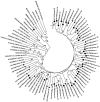HIV Drug Resistance Mutations and Subtype Profiles among Pregnant Women of Ho Chi Minh City, South Vietnam
- PMID: 37896785
- PMCID: PMC10612098
- DOI: 10.3390/v15102008
HIV Drug Resistance Mutations and Subtype Profiles among Pregnant Women of Ho Chi Minh City, South Vietnam
Abstract
According to the latest data released by UNAIDS, the global number of people living with HIV (PLHIV) in 2021 was 38.4 million, with 1.5 million new HIV infections. In different countries, a significant proportion of these cases occur in the adult fertile population aged 15-49 years. According to UNAIDS, Vietnam had a national HIV prevalence of 0.3% of the total population at the end of 2019, with approximately 230,000 PLHIV. The most effective way to prevent mother-to-child transmission of HIV is ART to reduce maternal viral load. HIV-infected pregnant women should undergo monthly monitoring, especially before the expected date of delivery. The aim of our work was to analyze subtypic structure and drug-resistant variants of HIV in pregnant women in Ho Chi Minh City. The study material was blood plasma samples from HIV-infected pregnant women: 31 women showed virological failure of ART, and 30 women had not previously received therapy. HIV-1 genotyping and mutation detection were performed based on analysis of the nucleotide sequences of the pol gene region. More than 98% of sequences genotyped as HIV-1 sub-subtype CRF01_AE. When assessing the occurrence of drug resistance mutations, genetic resistance to any drug was detected in 74.41% (95% CI: 62.71-85.54%) of patients. These included resistance mutations to protease inhibitors in 60.66% (95% CI: 47.31-72.93%) of patients, to NRTIs in 8.20% (95% CI: 2.72-18.10%), and to NNRTIs in 44.26% (95% CI: 31.55-57.52%). Mutations associated with NRTI (2) and NNRTI (8) resistance as well as PI mutations (12), including minor ones, were identified. The high prevalence of drug resistance mutations found in this study among pregnant women, both in therapeutically naive individuals and in patients with virological failure of ART, indicates that currently used regimens in Vietnam are insufficient to prevent vertical HIV infection.
Keywords: HIV; HIV drug resistance; human immunodeficiency virus; laboratory diagnostics; prevent mother-to-child transmission of HIV.
Conflict of interest statement
The authors declare no conflict of interest.
Figures





References
-
- World Health Organization HIV. Key Facts. [(accessed on 8 September 2022)]. Available online: https://cdn.who.int/media/docs/default-source/hq-hiv-hepatitis-and-stis-....
-
- IN DANGER: UNAIDS Global AIDS Update 2022 Geneva: Joint United Nations Programme on HIV/AIDS. 2022. [(accessed on 14 December 2022)]. Available online: https://www.unaids.org/en/resources/documents/2022/in-danger-global-aids....
-
- Roser M., Ritchie H. HIV/AIDS. Published Online at OurWorldInData.org. [(accessed on 8 September 2022)]. Available online: https://ourworldindata.org/hiv-aids.
-
- de Mendoza C. Hot News: HIV Epidemics—Current Burden and Future Prospects. AIDS Rev. 2017;19:239. - PubMed
MeSH terms
Substances
LinkOut - more resources
Full Text Sources
Medical
Molecular Biology Databases
Research Materials
Miscellaneous

